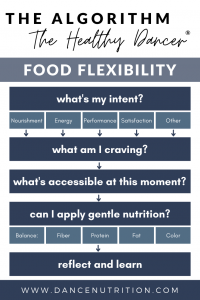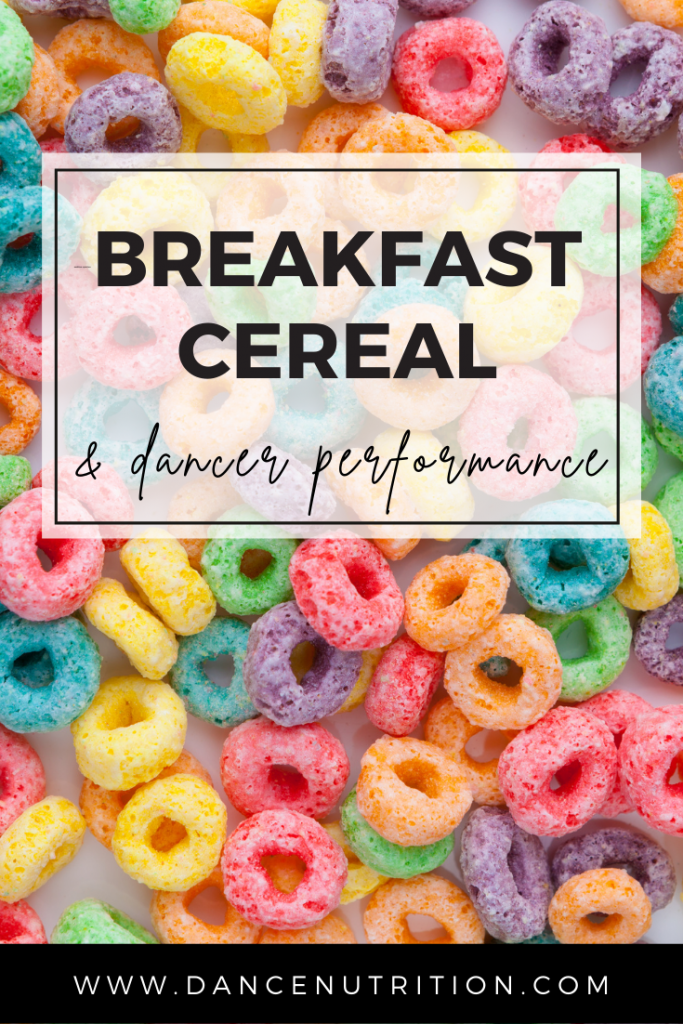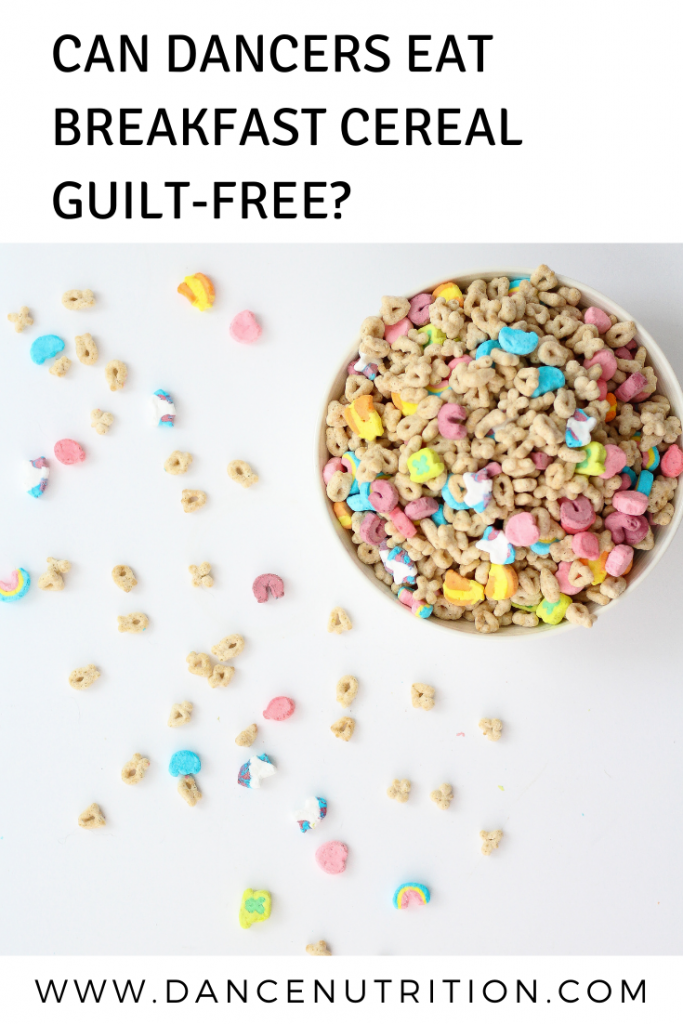Should Dancers Eat Breakfast Cereal?
If you’re a dancer questioning whether breakfast cereal is a smart choice to start your day, you’re in the right place. Thanks to diet culture’s long-standing fear of carbohydrates, foods like cereal are commonly scrutinized. But the truth is: breakfast cereals — and carbs in general — can have a place in a dancer’s balanced, performance-supportive diet.
In this article, we’ll challenge the myths, explore how cereal can fuel your dancing, and walk through how to optimize your bowl to align with your unique goals, all while enjoying your food, guilt-free.
Are Breakfast Cereals Healthy?
Breakfast cereals are primarily carbohydrate-rich, but not all cereals are created equal, nor should they be treated as “good” or “bad.” With the rise of low-carb and keto trends, we’ve seen a surge of “grain-free,” “low-carb,” and “high-protein” cereals marketed as healthier alternatives. But as I’ve discussed before, these often replace grains with processed starches (like potato starch), synthetic fibers (like chicory root), and sugar substitutes (like monk fruit and sugar alcohols)— all of which can cause digestive discomfort.
The role of carbohydrates in a dancer’s diet cannot be overstated. Carbs are your body’s primary energy source, directly fueling your muscles, brain, and nervous system. In addition:
- Fiber in grain-based cereals supports digestion and gut health.
- B vitamins found in grain-based carbs assist metabolism and energy production.
- Restricting carbohydrates (without medical necessity) often results in diminished endurance, digestive irregularity, slowed metabolism, and intensified cravings.
What About “Sugary” Cereals?
You know the ones: bright boxes, cartoon characters, puzzles on the back— cereals targeted toward kids and vilified by diet culture. Should dancers avoid them?
Not necessarily.
As a registered dietitian, I was trained to analyze how food marketing influences consumer choices. Diet culture amplifies fear around these cereals primarily due to two factors:
- Sugar content
- Additives and food dyes
Let’s start with uncovering added sugar. I’ve debunked the misconceptions about both added sugar (read about here) and chemical additives (read about here). But here are a few key points to consider:
- Eliminating added sugar entirely is not only unrealistic, it often backfires and can fuel disordered eating patterns.
- Contrary to popular belief, sugar itself is not inherently addictive. Restriction is a much bigger driver of binge behaviors. More on food addiction in this article.
- Research shows that consuming up to 10% of total daily calories from added sugar aligns with reduced heart health risks. For most dancers with higher energy needs, this allows for nearly 50 grams or more of added sugar daily— plenty of room for a bowl of cereal without sabotaging your health.
- Food Colorings and Additives:
- Regulated food dyes are considered safe with exposure by average and high-intake consumers far below the Acceptable Daily Intake (ADI).
- Current research does not support eliminating these from your diet unless there’s a specific sensitivity or allergy.
Bottom line: Sugary cereals are not inherently dangerous or harmful when consumed as part of a varied, balanced diet. Avoidance rooted in fear only perpetuates a rigid and unsustainable approach to food.
How To Choose a Breakfast Cereal That Supports Your Goals
Using The Healthy Dancer® Food Flexibility Algorithm, you can make food choices that honor both your physical needs and emotional well-being. Now, I realize how silly it sounds to associate your morning bowl of cereal with your emotional and mental well-being. But restrictive food rules can leave you feeling unsatisfied and, in the long term, sacrifice your relationship with food. So, let’s implement this fun algorithm that I designed for The Healthy Dancer®.
Here’s how:
The Healthy Dancer® Food Flexibility Algorithm
Not quite sure how to incorporate breakfast cereal in a way that is guilt-free? The Food Flexibility Algorithm can be used with any food or food group and involves a series of questions centered around discovery and reflection.

What’s My Intent?
Diet culture often suggests that intent be weight loss or body composition shifts. However, use food as a tool for performance and satisfaction. Ask yourself:
- Am I hungry?
- Do I need sustained energy?
- Am I preparing for a performance?
- Do I simply want to enjoy the nostalgic comfort of my favorite childhood cereal?
What Am I Craving?
Cravings are normal. They reflect both emotional memories and biological needs. Deprivation intensifies cravings, often creating the very binge-restrict cycle dancers fear. The longer you go without eating a specific food, the more likely you are to crave it. On the biological level, hormones like neuropeptide-Y and leptin drive cravings, specifically for energy-dense foods rich in carbohydrates and fat. Respecting your cravings helps build trust with your body.
What’s Accessible Right Now?
If you’re craving the nostalgia of sugary cereal and it’s accessible to you, great. But while listening to satiety cues and discovering satisfaction are both aspects of intuitive eating, they’re not the entirety.
A major part of intuitive eating that often gets lost in translation is the importance of food accessibility (learn more about this misconception and how to navigate through it). Contrary to only prioritizing satisfaction, intuitive eaters prioritize their body’s need for calories as nourishment. If you’re hoping for a higher-fiber cereal that supports longer energy, but all that’s available is an option deemed “highly processed” or “sugary,” then that is what will support your body at this moment. Food neutrality, a topic you can learn more about here, strips the glorification of some foods (most often “clean,” “whole” foods) and demonization of other foods (most often “processed” foods). Food neutrality for dancers reduces the shame and guilt often associated with foods that may be more accessible.
Can Gentle Nutrition Support My Goals?
When feasible, you can gently optimize your cereal without sacrificing satisfaction. Ask yourself: Will nutritionally optimizing this meal (or snack) leave me feeling satisfied and fulfilled? Here’s what to consider:
- Balance:
- Add protein (milk, soy milk, or yogurt).
- Include fats (chia seeds, flax, nut butters, chopped nuts). These additions help you feel fuller for longer.
- Fiber:
- When possible, choose cereals higher in fiber and lower in added sugars. Brands like Kashi, Nature’s Path, and Ezekiel are excellent options.
- Micronutrients:
- Add color! Top your bowl with fresh or frozen fruit for added vitamins, minerals, and antioxidants. But remember: many cereals are fortified, so you’re still getting nutrients even if produce isn’t accessible.
Reflection: Building Trust With Cereal (and All Foods)
Food choices won’t always feel perfect. Sometimes you’ll finish a meal feeling satisfied; other times, you may wish you’d chosen something different. This is part of building confidence and flexibility in your relationship with food.
For years, I avoided breakfast cereal, fearing I couldn’t control myself around it. Eventually, giving myself unconditional permission to enjoy cereal, whenever I wanted, broke the deprivation cycle. Today, I can enjoy my favorite Fruit Loops without guilt, knowing I can have them anytime I choose.
But let’s say I’m gearing up for a morning audition. A carbohydrate-rich breakfast will support my energy for the long morning ahead. Since a bowl of Fruit Loops is lower in fiber, protein, and fat, I’ll feel hungry shortly after eating. The higher sugar content may even leave me feeling sluggish by adage. Instead, I’ll plan to save that option for another time.
Remember: Your health isn’t determined by one meal or one bowl of cereal. It’s the consistent patterns you build over time. Use The Healthy Dancer® Food Flexibility Algorithm to guide you— not into perfection, but into balance, satisfaction, and trust.
Key Takeaways:
- Cereal can fit into a dancer’s balanced, performance-supportive diet.
- Sugar and food additives, when consumed in context, are not inherently harmful.
- Food flexibility and gentle nutrition empower dancers to eat without guilt or fear.
- Satisfaction, accessibility, and intent matter just as much as nutritional content.





